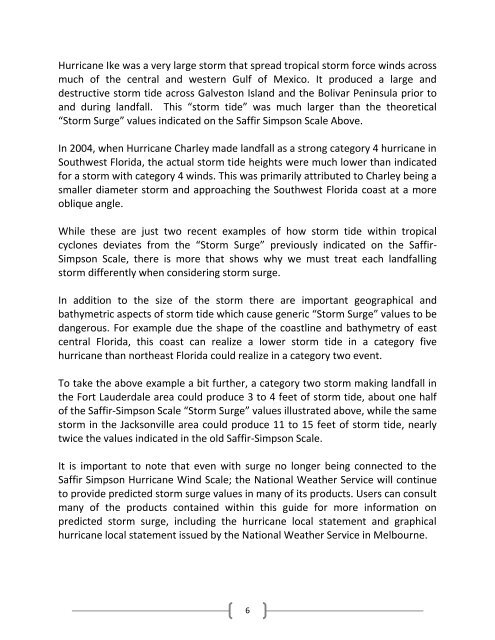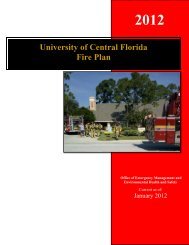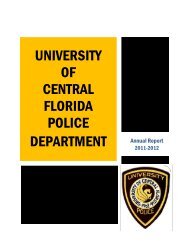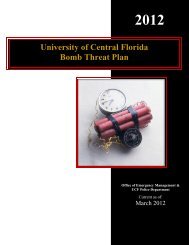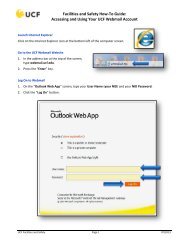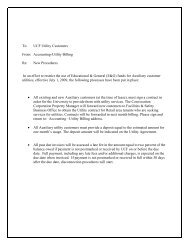University of Central Florida Severe Weather Plan - UCF Facilities ...
University of Central Florida Severe Weather Plan - UCF Facilities ...
University of Central Florida Severe Weather Plan - UCF Facilities ...
You also want an ePaper? Increase the reach of your titles
YUMPU automatically turns print PDFs into web optimized ePapers that Google loves.
Hurricane Ike was a very large storm that spread tropical storm force winds acrossmuch <strong>of</strong> the central and western Gulf <strong>of</strong> Mexico. It produced a large anddestructive storm tide across Galveston Island and the Bolivar Peninsula prior toand during landfall. This “storm tide” was much larger than the theoretical“Storm Surge” values indicated on the Saffir Simpson Scale Above.In 2004, when Hurricane Charley made landfall as a strong category 4 hurricane inSouthwest <strong>Florida</strong>, the actual storm tide heights were much lower than indicatedfor a storm with category 4 winds. This was primarily attributed to Charley being asmaller diameter storm and approaching the Southwest <strong>Florida</strong> coast at a moreoblique angle.While these are just two recent examples <strong>of</strong> how storm tide within tropicalcyclones deviates from the “Storm Surge” previously indicated on the Saffir-Simpson Scale, there is more that shows why we must treat each landfallingstorm differently when considering storm surge.In addition to the size <strong>of</strong> the storm there are important geographical andbathymetric aspects <strong>of</strong> storm tide which cause generic “Storm Surge” values to bedangerous. For example due the shape <strong>of</strong> the coastline and bathymetry <strong>of</strong> eastcentral <strong>Florida</strong>, this coast can realize a lower storm tide in a category fivehurricane than northeast <strong>Florida</strong> could realize in a category two event.To take the above example a bit further, a category two storm making landfall inthe Fort Lauderdale area could produce 3 to 4 feet <strong>of</strong> storm tide, about one half<strong>of</strong> the Saffir-Simpson Scale “Storm Surge” values illustrated above, while the samestorm in the Jacksonville area could produce 11 to 15 feet <strong>of</strong> storm tide, nearlytwice the values indicated in the old Saffir-Simpson Scale.It is important to note that even with surge no longer being connected to theSaffir Simpson Hurricane Wind Scale; the National <strong>Weather</strong> Service will continueto provide predicted storm surge values in many <strong>of</strong> its products. Users can consultmany <strong>of</strong> the products contained within this guide for more information onpredicted storm surge, including the hurricane local statement and graphicalhurricane local statement issued by the National <strong>Weather</strong> Service in Melbourne.6


